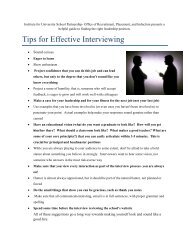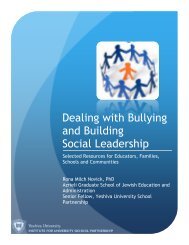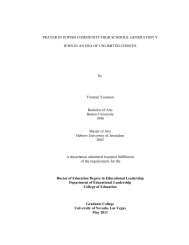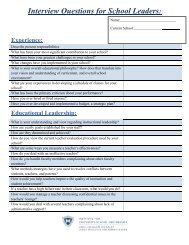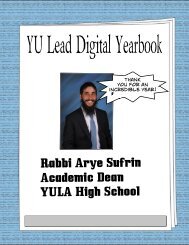Improving Instructional Quality in Jewish Day Schools and Yeshivot ...
Improving Instructional Quality in Jewish Day Schools and Yeshivot ...
Improving Instructional Quality in Jewish Day Schools and Yeshivot ...
Create successful ePaper yourself
Turn your PDF publications into a flip-book with our unique Google optimized e-Paper software.
participation. Teacher focused <strong>in</strong>struction decreases <strong>and</strong> studentfailure to respond is reduced.Benefits <strong>in</strong>clude <strong>in</strong>creases <strong>in</strong> (see http://med.fsu.edu/education/FacultyDevelopment/notesbackofroom.asp):1. the length of student responses2. student <strong>in</strong>itiated <strong>and</strong> appropriate responses3. the number of students’ respond<strong>in</strong>g4. student confidence <strong>in</strong> respond<strong>in</strong>g5. student speculative responses <strong>in</strong>crease6. student to student <strong>in</strong>teractions7. student evidence to support statements8. the number of student questions9. the participation of “slow” students10. the variety of student responsesSuccessful teachers use wait time <strong>in</strong> various ways. Here’s how oneteacher reported his use of wait time: “I pose a question. I don’t call onanyone before about 7 seconds even if someone raises a h<strong>and</strong>immediately. I allow th<strong>in</strong>k time. What happens if after 7 seconds noone responds? I ask myself, ‘Do I need to rephrase the question?’ If so,I do <strong>and</strong> start aga<strong>in</strong>. If not, I ask them to pair <strong>and</strong> share thoughts aboutpossible answers. I give them about 60-90 seconds. This techniquealways yields results. Students give their answers. Not always,however, are the answers right, but at least they had time to reflect<strong>and</strong> respond.”Best Practice #3: Check<strong>in</strong>g for Underst<strong>and</strong><strong>in</strong>gUse of formative assessments has received much attention <strong>in</strong> theliterature on classroom effectiveness (Brookhart, 2008; Moss &Brookhart, 2009; Popham, 2008a). Here are a few techniques culledfrom this literature:1. Use pair <strong>and</strong> share – Upon teacher prompt, one student turns toanother to repeat or expla<strong>in</strong> the concept just reviewed by theteacher.2. The M<strong>in</strong>ute Paper (Angelo & Cross, 1993) – The teacher takesthe last m<strong>in</strong>utes of class <strong>and</strong> asks the student to write down51



